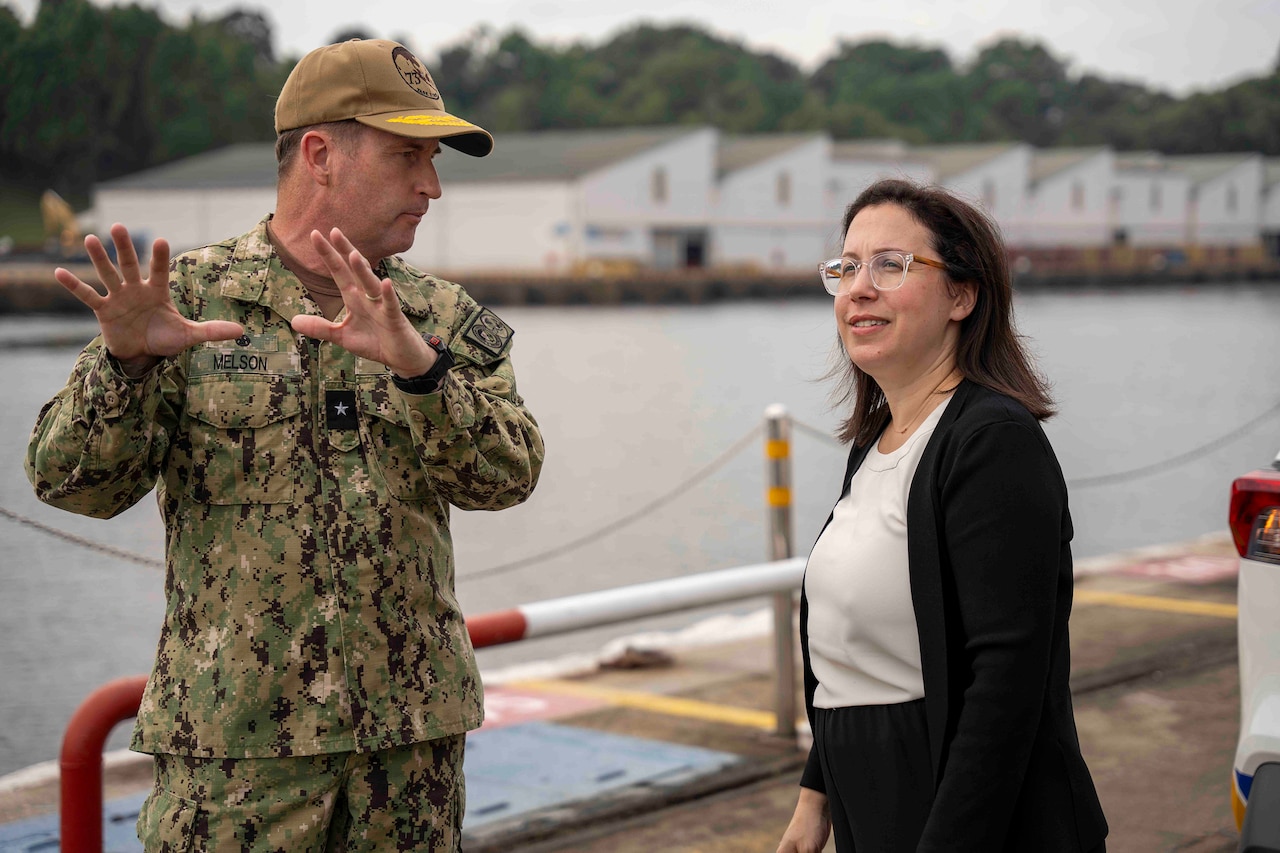A football team is only as good as the game plan it follows, and the same could be said for the Defense Department.
A football team cannot have the receivers running routes the quarterback doesn’t expect, nor can linemen block just whomever they want. This doesn’t mean there can’t be adjustments as the game progresses, but everyone on the team must work toward a common purpose.
Secretary of Defense Lloyd J. Austin III has said this is an uncertain time with Russia invading Ukraine, China looking to overturn the international security order, Iran sowing disorder throughout the Middle East and North Korea developing nuclear weapons and the means to deliver them. On top of that, the world still must guard against the dangers posed by violent extremist groups like Hamas, the Islamic State and al-Qaida.
The DOD team must work together to confront these many challenges, said Sasha Baker, the acting undersecretary of defense for policy. Baker, who leaves office at the end of this month, spoke of the efforts the Pentagon “Policy Shop” has made to ensure all aspects in the department work together to achieve the country’s security goals.
Ukraine is a classic example of this effort. “It has been an all-hands-on-deck effort,” she said. “And it I think Policy has played a lead, convening role in making that happen and bringing together the different elements of the department — the services, the [defense] components, the combatant commands that have equities.”
When Russia invaded Ukraine in February 2022, many observers expected Russia would achieve a quick victory. On paper, Vladimir Putin’s military vastly outnumbered and outgunned Ukraine. Even before the invasion, the U.S. government was shipping Ukraine the equipment it needed to defend its sovereignty. Once Russian troops approached the Ukrainian capital of Kyiv, that effort went on steroids.
Austin convened meetings of like-minded nations in the Ukraine Defense Contact Group, which has grown to an alliance of more than 50 nations. It started with the group sending anti-armor weapons like Javelins and anti-air Stinger missile systems. It grew to highly accurate tube-launched and rocket artillery, armored vehicles, tanks and more.
“It has truly been a whole of department effort, everyone from … the Army scouring its stocks to dig deeper and find equipment, through to [the U.S. Transportation Command], figuring out new ways to move things as fast as possible so that it gets to Ukraine at the moment of need,” Baker said. “And all of that has had to be almost invented out of whole cloth.”
While the department has had presidential drawdown authority for years, it has never been used to this scope, she said. “It’s typically limited to a couple $100 million a year. And we’ve moved over upwards of $50 billion at this point.”
This has required DOD to bust through bureaucratic barriers and invent new ways of doing things, she said. The “beating heart” of this process goes by the totally bureaucratic name of “the cross-departmental working group.” The group has become pivotal in funneling aid to Ukraine. The policy office chairs the group, and it includes the services, the joint staff, the U.S. European Command, Transcom and the various staff functions that grease the skids in government.
“It is everybody who has an equity,” Baker said. “And we sit around the table and we debate and everyone essentially gets a vote or an ability to make a recommendation to the secretary from their perspectives and their equities.”
The group balances Ukraine’s crucial needs with DOD’s own readiness concerns. “We have to go through all of those wickets, but it’s not like rocket science to do this,” she said. “But having everybody be in the same room at the same time has been a game changer. Because rather than us circulating a piece of paper around the department where everyone takes a week with it, we’re all in the room. If people have questions they can get answered in real time. If there’s a debate, we can have it face-to-face. It has expedited the process and allowed us to provide the secretary with recommendations that are timely for something that’s clearly urgent.”
And it was all brand new. Nothing like this had been done in the past. But now it is part of the muscle memory of the department, Baker said, and when Congress approves the new money for Ukraine, the groups will be able to continue without a hiccup.
Baker praised the work of the Defense Security Cooperation Agency, which runs the foreign military sales process. This small agency “has stepped up in a huge way,” she said. “They do all of the back end around this: The execution orders, the tracking, the nitty gritty details.”
Underpinning all this, however, is the National Defense Strategy. This is the document that sets the parameters for the department, its missions and how the various DOD entities will work together. Secretary Austin emphasizes the strategy in almost every public utterance. It is the document that calls China DOD’s “pacing challenge” and Russia an “acute threat.” It looks to Iran, North Korea and terror groups as dangers that need to be monitored and addressed. It also is the strategy that ensures the department provides the resources to take care of service members and their families.
The importance of defense strategies in the past have waxed and waned depending on the threats and U.S. circumstances.
This strategy is a living breathing document.
“This is not a document that’s designed to just sit on a shelf and then be forgotten,” Baker said.
The strategy is a priority for Secretary Austin and the undersecretary for policy is instrumental in ensuring that any decisions made conform with that document. “It was [Secretary Austin’s] vision to do it this way, to embed the strategy in everything that we do,” she said. “We wrote not only a strategy, but also an implementation plan for the strategy that looks at every task that is in the strategy — whether it’s explicit or implicit — and assigns to it an office of primary responsibility. So everyone knows what the strategy expects of them.”
What’s more, Austin has asked for quarterly progress reports on these implementation plans. “We’re constantly measuring ourselves in our progress against the strategy,” she said.
And the department looks to amend the strategy as needed. Baker said there was a conscious effort to ensure there was flexibility in the strategy to account for new situations, challenges and threats.
This strategy is used to formulate budgets. “We have what I think is an alignment between the strategy and the budget that really, I have not seen in the past,” Baker said.
She said Deputy Defense Secretary Kathleen Hicks has been instrumental in the process of consulting the strategy in budgetary matters. “She is deeply aware of the role that these documents … can play in driving change in this building.”
As the budget is built, DOD officials have to ask if a proposal aligns with the strategy.
Another part of the strategy is the emphasis on working with allies and partners around the world, and of course, the policy office has a large role to play.
Since the French came to the aid of the fledgling United States during the Revolution, the United States has depended on allies. Outreach to established allies and friends must continue, as should outreach to other nations.
Baker noted the paucity of allies that Russia has, with Vladimir Putin depending on Iran and North Korea for aid in its illegal war on Ukraine.
“President [Joe] Biden believes to his core, that we are stronger when we work with our allies and partners, that it is a unique advantage that we have in the world,” Baker said.
NATO is the poster child of this effort with 32 nations in the defensive alliance now. But the Indo-Pacific region is where the greatest change has happened. The relationships among treaty allies Australia, South Korea, Japan, the Philippines and Thailand are closer now than they have ever been, she said.
The U.S. outreach to the nations of Southeast Asia including Vietnam, Singapore, Malaysia, Indonesia and others has been met with acceptance and trust.
The biggest change may be the U.S. relationship with India. The two countries have signed coproduction deals for military capabilities that would have been unthinkable just a decade ago, Baker said.
“There is just a real competitive advantage that we have when we approach the world because we are almost never doing it alone,” she said. “And it has been the primary effort of this administration, and certainly my tenure in this role, to do everything we can to broaden and deepen those partnerships and those alliances, and we’re making progress across the board.”
Looking ahead, Baker says the nation is “on the cusp of the next great American generation on the world stage.”
This is a decisive decade, because there is a series of choices that must be made, she said. “What are we going to do to tackle climate change? And how are we grappling with the sort of guard rails and left and right boundaries for new technologies, whether that is artificial intelligence, or hypersonics, or quantum computing, or something that we can’t imagine?”
A key is how the United States manages the geopolitical situation with China, which looks to be the most consequential relationship of the remainder of the 21st century.
“All of these are choices we have to make, which I believe will reverberate in a positive way, for generations … to come,” she said.
This article, Office Works to Unify DOD Responses, Efforts Across the Globe, was first published by The Department of Defense.








